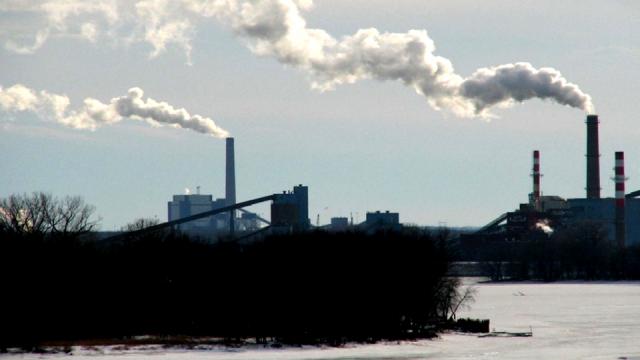
Photo: Mike Fuller. View across Mississippi River looking towards factory in Muscatine, Iowa
In the Mississippi River town of Muscatine, Iowa, concerns about a corn processing plant that belches smoke and ash over the South End neighborhood have festered for years.
This week, those living in the plant’s shadow took a step that, until recently, would have seemed unlikely at best: They sued the plant’s owner, Grain Processing Corporation — a vital piece of the town’s economy and a political force in Iowa.
For years, the lawsuit alleges, residents have put up with constant pollution that has damaged their property and affected their health. The Center for Public Integrity detailed the persistent haze hanging over the community and the company’s long history of run-ins with regulators as part of its “Poisoned Places” series with NPR last year.
“We’ve reached a tipping point in Muscatine,” said Tony Buzbee, a Houston lawyer with a history of winning high-profile environmental cases who has agreed to represent the residents. “I think that you’re going to see hundreds and hundreds of people who have the courage to stand up and say, ‘We’re in the right, and we’re not going to take it anymore.’ ”
Buzbee joins Jim Larew, who was general counsel to former Governor Chet Culver, and Des Moines lawyer Andrew Hope in representing the residents, who are seeking to make the case a class action that anyone living within three miles of the plant could join.
The petition filed Monday, Buzbee said, is “just the tip of the iceberg.” He plans to file hundreds more cases. “It’s going to cost a lot of money,” he said. “It’s going to be a big fight.”
Grain Processing Corporation spokesperson Janet Sichterman said the company, known as GPC, hadn’t received a copy of the lawsuit and had no comment on it.
Before filing suit, Buzbee commissioned tests of the air near the plant, which sits just across the street from the neighborhood known as the South End. Levels of one compound, acetaldehyde, were “dangerously high,” the petition alleges. The finding is crucial, Buzbee said, because, unlike some of the pollutants in Muscatine’s air, acetaldehyde could come from only one place: GPC.
As the Center documented, GPC reported releasing more acetaldehyde — a substance the Environmental Protection Agency considers a probable carcinogen — than almost any plant in the country in 2010. A state inspector has repeatedly noted a “blue haze” coming from some of the plant’s smokestacks that could indicate the presence of acetaldehyde. The state began studying these and other toxic emissions from GPC in 2010, but the effort has since been placed on hold.
The lawsuit says GPC “has used, and continues to use, worn machineries, outdated manufacturing technologies and outdated pollution-abating technologies while at the same time increasing production.” As the Center found, regulators have allowed GPC to avoid upgrading its pollution-control equipment, even as many of its competitors have modernized.
For example, a state inspector unsuccessfully pushed his bosses to make GPC install a baghouse — a large structure to house filters that would remove pollutants from smoke leaving a stack. The company already owned the device but, after regulations requiring it were vacated, refused to hook it up.
GPC also faces potential enforcement cases from both state and federal regulators. The day after the Center’s first story about Muscatine, the state filed a lawsuit, alleging that GPC had released more air pollution than allowed for at least the previous 18 months. The allegations relate to the same air pollution rules that the company had agreed not to violate as part of a settlement agreement with the state in 2006.
In March, the EPA sent GPC a notice of violation, accusing the company of repeatedly violating air pollution rules between 2007 and 2011, and failing to report episodes when pollution exceeded allowed limits. Though the agency would not elaborate on the allegations, the Center has reported that a state inspector began raising concerns as early as 2008 that GPC appeared to be misusing exemptions to conceal frequent violations.
GPC has announced that it plans to spend about $100 million to upgrade much of the plant, including some pollution control equipment. Some of the work is scheduled to be finished in 2014. But state regulators have said the improvements may not go far enough to ensure the area meets EPA standards designed to protect public health.
3 WAYS TO SHOW YOUR SUPPORT
- Log in to post comments











